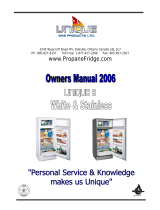
UNIQUE UGP 3
9
1. “DEF” Defrost setting on the Gas/Electric Thermostat: In gas operation, the
thermostat closes its main valve and the burner runs continuously at the bypass rate or
pilot flame. (turn fully counter clockwise), and in 110V operation the element will cycle
off, until cooling is again required.
2. “MAX” Setting of the Thermostat: In gas operation, the thermostat allows the
burner to remain on high flame continuously. (turn clockwise), and in 110V operation the
element will stay on until the desired temperature is reached inside the fridge.
3. The thermostat can be adjusted between “Max” and “Warm” to obtain the desired
fridge temperature. When the thermostat reaches the set temperature, it will reduce the
burner back to bypass operation or shut the element off in 110V operation.
4. In DC operation the fridge will only maintain the temperature that’s already been
achieved. There is no thermostatic function.
When operating on 110V or LP gas, the setting of the thermostat is critical and
recommend it be adjusted to maintain a dry frost on the cooling fins (approx. 38
Fahrenheit or 3 Celsius). Adjust the thermostat knob closer to “Max” (clockwise) when
the ambient temperature rises.
How to Use the Refrigerator
FOOD STORAGE COMPARTMENT
The food storage compartment is completely closed and unventilated, this is necessary to
maintain the required low temperature for food storage. The coldest areas in the
refrigerator are under the cooling fins and at the bottom of the refrigerator. The warmer
areas are on the upper door shelves. This should be considered when placing different
types of food in the refrigerator.
FROZEN FOOD STORAGE COMPARTMENT
This compartment is not designed for deep or quick freezing of food. Meat or fish,
whether raw or prepared, can be stored in the frozen food storage compartment provided
they are pre-cooled in the refrigerator. To prevent food from drying out, keep it in
covered dishes, containers, plastic bags or wrapped in aluminum foil.
Defrosting
Frost will gradually accumulate inside the refrigerator and freezer surfaces. It must not be
allowed to grow too thick as it acts as an insulator and adversely affects the refrigerator




























